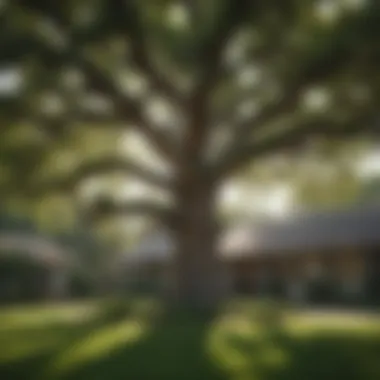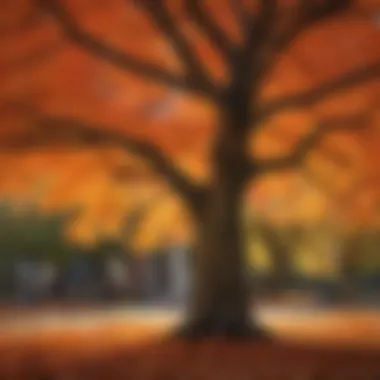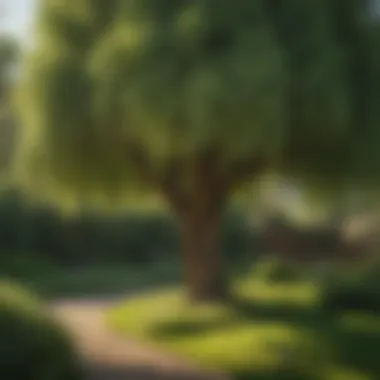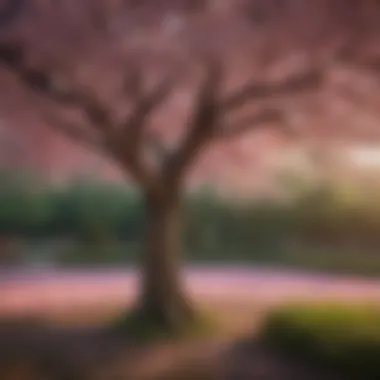Best Shade Trees for Your Front Yard


Intro
Selecting the right shade trees for your front yard can have a substantial impact on the overall aesthetic and functionality of your property. Shade trees provide more than just a cooling area. They enhance the visual appeal, create a welcoming atmosphere, and increase the ecological value of your landscape.
In this guide, we will explore various species of shade trees suitable for front yards. We will touch on their unique characteristics, benefits, and the environments where they thrive best. By understanding these elements, homeowners can make informed decisions that align with their landscaping goals.
Key Insights and Trends
As society places increasing importance on outdoor living spaces, shade trees are becoming focal points in front yard designs. Homeowners are looking for trees that not only provide shade but also contribute positively to the environment. Recent trends show a preference for native species, as they are adapted to local conditions and support local wildlife.
The push for sustainability influences choices in shade trees. Many homeowners prioritize trees that improve air quality, reduce energy costs, and promote biodiversity. In addition, urban areas are seeing a rise in vertical gardening techniques that complement shaded areas, effectively utilizing space while enhancing beauty.
"The right shade tree can transform not just your yard, but your entire home environment."
Practical Tips and How-To Guides
Choosing the best shade trees involves several considerations. Here are practical tips to guide your selection:
- Evaluate Your Space: Measure your front yard to determine how much area is available for a tree. Consider existing structures, other plants, and sunlight availability.
- Understand Growth Patterns: Research the mature height and spread of different tree species. Large trees may not be suitable for smaller yards.
- Consider Maintenance: Some trees require more upkeep than others. Ensure you choose a tree that fits your desired maintenance level.
Popular Shade Trees to Consider
- Red Maple (Acer rubrum)
- Sugar Maple (Acer saccharum)
- Oak Trees (Quercus spp.)
- Linden Tree (Tilia spp.)
- Known for its vibrant fall color and adaptability.
- Thrives in various soil types and tolerates wet conditions.
- Celebrated for its autumn shades.
- Prefers well-drained, fertile soil.
- Offers extensive shade and long life.
- Ideal for larger yards due to their significant spread.
- Features fragrant flowers in summer and lovely foliage.
- Adaptable to urban environments.
Prolusion to Shade Trees
Shade trees play a crucial role in enhancing residential landscapes while providing significant environmental benefits. Their presence not only provides cool relief during hot summer months but also contributes to reducing energy costs by moderating indoor temperatures. Additionally, shade trees improve air quality and absorb carbon dioxide, making them essential for a healthier ecosystem.
Homeowners often overlook the importance of selecting the right shade tree for their front yard. This choice goes beyond aesthetic appeal; it influences biodiversity, property value, and even personal comfort. Understanding the benefits and characteristics of various shade trees can help homeowners make informed decisions that integrate seamlessly into their living spaces.
Before planting, it’s important to consider several factors to ensure the tree thrives in its designated space. Resistance to pests and diseases, maintenance requirements, and growth habit are all relevant factors that will affect tree longevity and health.
"Choosing the right shade tree is vital for a landscape's overall sustainability and beauty."
The Importance of Shade Trees
Shade trees are more than just decorative elements. They serve numerous functional purposes. Firstly, they provide essential shade, which can significantly lower outdoor temperatures. This is especially beneficial in urban areas where the heat island effect can raise temperatures significantly.
Furthermore, these trees serve as habitats for various wildlife, promoting biodiversity in suburban neighborhoods. Their dense foliage can also act as a natural sound barrier, reducing noise pollution. Overall, the ecological benefits of shade trees are immense and provide long-lasting rewards for both the environment and homeowners.
Selection Criteria for Shade Trees
Climate
Climate influences everything from growth rate to longevity in trees. Selecting a shade tree suited for the local climate is fundamental for ensuring its success. Generally, trees that thrive in warm climates may suffer in colder regions, while vice versa may also apply. The key characteristic of climate is temperature patterns, which dictate the types of trees that can be planted. Opting for species like the Southern Live Oak is beneficial in warmer regions, while Sugar Maples are preferable in colder areas. However, variability in climate conditions, such as unpredictability in weather patterns, can pose unique challenges for tree growth.
Soil Type
Soil type directly affects a tree's ability to absorb water and nutrients. Good drainage, pH levels, and organic matter content are core aspects. Certain trees prefer sandy soils, while others thrive in clay. For instance, Red Maples are adaptable and can grow in a variety of soil types, while Black Walnut prefers well-drained soil. Failure to select a tree compatible with the soil can lead to stunted growth or death, underlining the need for careful consideration.
Space Requirements
Space requirements refer to the area a tree will need to grow both above and below ground. It’s important to consider the key aspect of how the tree will fit into the landscape as it matures. Trees like the Silver Maple can grow large and may not be suitable for small yards, while smaller varieties such as the Japanese Flowering Cherry are typically more appropriate for tighter spaces. Adequate space prevents crowding, which can reduce light penetration and air circulation, both crucial for tree health.
Types of Shade Trees


Understanding the types of shade trees is crucial for homeowners seeking to enhance their front yards. The right trees not only provide shade but also contribute significantly to the overall aesthetics and ecological balance of your property. Shade trees serve as natural air conditioners, reducing heat in your yard and home, which can lead to lower energy costs. Additionally, these trees improve air quality and provide habitat for wildlife, making them an essential consideration in landscaping.
Deciduous Trees
Characteristics
Deciduous trees are defined by their ability to shed leaves in the fall. This characteristic allows them to conserve water during harsh winters. Their leafless structure in winter reveals the elegance of their branches, providing a different aesthetic seasonally. Notable examples include the Oak and Maple, known for their sturdy branches and vibrant fall colors. Their ability to grow tall and wide makes them excellent choices for areas needing substantial shade.
Benefits
One significant benefit of deciduous trees is their seasonal changes. In spring and summer, they provide ample shade, cooling your yard and home. In contrast, during fall and winter, they allow sunlight to warm your space. This dual purpose makes them a practical option for various climates. Their large root systems also help prevent soil erosion, promoting healthier landscapes.
Popular Varieties
Popular varieties of deciduous trees include the Sugar Maple and Red Oak. The Sugar Maple is favored for its beautiful coloration and strong structure. It can thrive in various soil types, making it adaptable. The Red Oak is another excellent choice, known for its rapid growth and resilience. These trees maximize both beauty and function in a front yard setting.
Evergreen Trees
Characteristics
Evergreen trees retain their foliage throughout the year, offering consistent greenery. This characteristic makes them appealing for year-round visual interest. Common types include Pine and Spruce, known for their needle-like leaves and conical shapes. Their ability to grow taller than many deciduous trees allows for a unique contrast in height and aesthetics in your yard.
Benefits
Evergreen trees provide continuous shade, a crucial element for landscaping. They also act as natural windbreaks, protecting your home from harsh winds. Their thick foliage helps reduce noise pollution, creating a serene outdoor environment. Additionally, they are often lower maintenance compared to deciduous trees.
Popular Varieties
The Eastern White Pine and Colorado Blue Spruce are top choices among evergreens. The Eastern White Pine is renowned for its tall, graceful structure and fast growth. It adapts well to various soil conditions. Meanwhile, the Colorado Blue Spruce is appreciated for its stunning blue color and dense foliage, which can serve as a focal point in the landscape, enhancing visual appeal.
Popular Shade Trees for Front Yards
Shade trees play a significant role in enhancing the aesthetic appeal and ecological balance of front yards. These trees provide relief from heat by lowering the surrounding temperature and creating a comfortable outdoor environment. Moreover, their mere presence can elevate the overall charm and value of the property. When choosing shade trees for front yards, it is essential to consider various factors, such as growth characteristics, ecological benefits, and adaptability to local climates. Here, we will explore some of the most popular shade trees, starting with oak and following through to cherry blossoms, each selected for their unique contributions to residential landscapes.
Oak Trees
Growth Characteristics
Oak trees are renowned for their sturdy structure and longevity. They generally reach heights between 60 to 100 feet, depending on the species. Oak trees typically have a broad canopy, making them effective in providing shade. The leaves can be quite large, offering significant coverage during the warmer months. This adaptability to diverse soil types contributes to their popularity among homeowners.
Ecological Benefits
In terms of ecological contributions, oak trees support various wildlife, including birds, insects, and squirrels. The acorns produced by oak trees serve as a food source for many animals. Their extensive root systems also help to prevent soil erosion, making them a beneficial addition to any yard. Oaks are often favored for their role in fostering biodiversity, thereby enhancing the ecological balance.
Maple Trees
Growth Characteristics
Maple trees are known for their spectacular fall foliage, transforming landscapes into vibrant displays of color. They can grow anywhere from 30 to 100 feet tall. The shallow root systems of maples can make them suitable for suburban areas where space is limited. Their relatively fast growth rate also makes them an appealing choice for those seeking immediacy in canopy coverage.
Ecological Benefits
Maples contribute to the environment through their ability to absorb carbon dioxide and release oxygen. Their large leaves provide shade, which helps reduce the urban heat island effect. Moreover, they attract various pollinators, including bees, fostering a healthy ecosystem. This dual string of aesthetic beauty and ecological benefits makes maple trees a popular option for front yards.
Birch Trees
Growth Characteristics
Birch trees are elegant and well-regarded for their distinctive white bark. They typically reach heights of 30 to 60 feet. Their slender form and light canopy make them suitable for tighter spaces, which often fits well into residential front yards. Additionally, birches exhibit relatively quick growth, establishing themselves as noticeable features in no time.
Ecological Benefits
Birch trees also play a vital role in the ecosystem. They are known to improve soil health through nitrogen fixation. This ensures that the surrounding plants thrive. The bark of birch trees can be habitat material for various insects and birds, enhancing local biodiversity. Their contribution to ecological health makes birches a wise choice for sustaining a balanced environment.


Sweetgum Trees
Growth Characteristics
Sweetgum trees are distinctive due to their star-shaped leaves and corky bark. They generally reach heights of 60 to 100 feet, and their dense foliage provides excellent shade coverage. These trees also thrive in a variety of soil conditions, making them adaptable for different front yard environments.
Ecological Benefits
Sweetgum trees produce a unique seed pod that serves as food for wildlife. Their dense canopies are beneficial to birds, offering them shelter from predators. Additionally, they help in increasing soil health with their fallen leaves, enriching the ground with organic matter. By planting sweetgum trees, homeowners may contribute greatly to the local ecosystem while enjoying their striking appearance.
Cherry Blossom Trees
Growth Characteristics
Cherry blossom trees are beloved for their stunning blooms that signify the arrival of spring. They grow to between 20 to 40 feet tall. These trees typically have a rounded canopy that provides moderate shade. Their relatively low maintenance is another reason homeowners find them appealing, as they don't require extensive care.
Ecological Benefits
The blossoms of cherry trees are a significant attraction for bees and butterflies, promoting pollinator activity. Additionally, their shallow root systems help improve soil aeration. This can lead to healthier ground for other plants. Overall, the combination of beauty and ecological contributions makes cherry blossom trees a cherished choice for enhancing front yard landscapes.
"Selecting the right shade tree not only beautifies your yard but also contributes to environmental balance. Choose wisely for lasting benefits."
In summary, popular shade trees like oaks, maples, birches, sweetgums, and cherry blossoms each offer unique growth characteristics and ecological benefits. By considering these attributes, homeowners can select trees that not only satisfy their aesthetic desires but also promote a healthier planet.
Factors Affecting Tree Growth
Understanding the factors that affect tree growth is essential when considering the right shade tree for your front yard. Proper tree growth is fundamental to ensuring that the tree will flourish and provide the intended ecological and aesthetic benefits. Several elements can impact growth, including environmental factors, soil conditions, and care practices. Recognizing these aspects can help homeowners make informed choices that align with their landscaping goals.
Environmental Considerations
Sunlight
Sunlight is a critical component for tree growth. Trees need adequate sunlight to carry out photosynthesis, a process that converts light energy into chemical energy for growth. Different species of shade trees have varying sunlight requirements. For example, some trees thrive in full sun, requiring six or more hours of direct light, while others prefer partial shade. Understanding the sunlight needs of each tree species helps in placing them correctly in the front yard, ensuring they receive appropriate light.
The unique feature of sunlight is its role in determining the overall vigor of the tree. Insufficient light can lead to stunted growth, poor leaf quality, and lower resistance to pests. Conversely, too much direct sunlight can stress some trees, leading to leaf scorch or even death. It is vital to consider the exposure and orientation of your front yard when selecting shade trees.
Moisture Levels
Moisture levels in the soil directly influence tree health and growth. Water is essential for trees, supporting physiological functions such as nutrient transport and photosynthesis. Different species have differing tolerance levels to moisture; some prefer consistently moist conditions, while others are drought-resistant.
A key characteristic of moisture levels is that they can vary significantly between seasons and weather patterns. Overwatering can suffocate roots, while insufficient water can lead to dehydration. Therefore, assessing the moisture needs of individual tree species helps create an optimal growing environment. This understanding allows for effective watering schedules and techniques to maintain healthy trees.
Wind Exposure
Wind exposure also plays a role in tree growth. Trees in exposed areas face the risk of uprooting or breakage during storms. It's important to select tree species that can withstand the prevailing wind conditions in your area. For example, some trees naturally develop stronger root systems or more flexible branches to cope with strong winds.
The main benefit of recognizing wind exposure is that it can prevent future issues. Trees that are ill-suited to their environment may suffer from physical damage or die prematurely. Evaluating wind patterns in your front yard can guide the selection of shade trees that are resilient and can thrive despite challenging conditions.
Soil Preparation
Testing Soil Quality
Testing soil quality is a fundamental step in preparing for tree growth. Healthy soil is rich in nutrients, well-drained, and supports root development. A soil test provides insight into the pH level, nutrient content, and organic matter, all of which influence tree health.
The benefit of understanding soil quality lies in how it prepares you for successful planting. For instance, if the soil is too acidic or basic, it can hinder a tree's ability to absorb essential nutrients. Knowing these details allows gardeners to make amendments to optimize growing conditions.
Amending Soil
Amending soil refers to the process of enhancing the soil structure and nutrient profile. This can involve adding organic matter, such as compost, or adjusting pH with lime or sulfur. Such amendments improve drainage and nutrient availability, fostering an environment conducive to healthy tree growth.
A notable aspect of soil amendment is its long-term benefits for the entire landscape. Improved soil conditions support not only the newly planted trees but also surrounding plants. Thoughtful amendments can mitigate potential issues related to drainage or nutrient depletion in the future. By ensuring soil is prepared properly, you can increase the likelihood of robust, thriving shade trees in your front yard.
Maintenance and Care


Maintaining shade trees is a critical aspect of ensuring their health and longevity. Proper maintenance practices not only enhance the aesthetic appeal of your front yard but also contribute to the ecological balance in your environment. Healthy trees withstand the stresses of weather fluctuations, pests, and diseases, providing the necessary benefits such as shade, wildlife habitat, and beautification. Attention to the specific needs of shade trees can lead to vibrant landscapes and improved property value.
Watering Techniques
Watering is a fundamental element in the care of shade trees. Newly planted trees require consistent moisture to establish their root systems. It is advisable to water young trees deeply at least once a week. This encourages deep root growth, allowing the tree to access nutrients and water from a larger soil volume.
For established trees, the watering frequency can be reduced. However, during extended dry spells, it may be necessary to provide supplemental water. Ensure to apply water at the base of the tree, avoiding foliage to prevent fungal diseases. To gauge soil moisture, stick a finger into the soil; if it feels dry within a couple of inches, it's time to water again.
Pruning Guidelines
Pruning is essential for maintaining tree shape, health, and safety. It involves the removal of dead or unhealthy branches, which helps reduce the risk of disease spread. Ideally, pruning should be conducted during the dormant season, typically in late winter or early spring.
Follow these guidelines for effective pruning:
- Remove dead or damaged branches first.
- Cut at the branch collar, which is where the branch meets the trunk, to promote healing.
- Avoid excessive cutting; remove only what is necessary to maintain shape and health.
- Use clean, sharp tools to make clean cuts, minimizing injury to the tree.
Pruning can also enhance air circulation and sunlight penetration, both of which are crucial for tree health.
Fertilization Strategies
Fertilization supports the growth of shade trees by replenishing essential nutrients in the soil. Conduct a soil test to determine which nutrients are deficient. Typically, a balanced fertilizer can improve tree vigor if applied at the right time.
Recommended fertilization strategies include:
- Spring application: Apply fertilizer in early spring as trees begin to grow.
- Use slow-release formulas: This provides a steady supply of nutrients over time, reducing the risk of over-fertilization.
- Follow product instructions carefully: Over-fertilization can harm the tree and the surrounding environment.
Additionally, organic options like compost can enrich the soil without the risk of chemical buildup.
Proper maintenance of shade trees is not only about aesthetics; it’s about cultivating a resilient ecosystem that benefits the environment as a whole.
Overall, effective maintenance and care contribute significantly to the health and longevity of shade trees. By implementing proper watering, pruning, and fertilization techniques, homeowners can enjoy the many benefits these trees provide for years to come.
Common Challenges and Solutions
Selecting shade trees for your front yard comes with its own set of challenges. Understanding these common issues is essential for ensuring the long-term health and beauty of your trees. Improper management can lead to significant problems that affect not just the trees, but also the overall health of the landscape. Addressing challenges like pest infestations and diseases effectively can minimize damage and encourage growth.
Pest Management
Pests can be one of the most significant threats to your shade trees. These insects and animals can cause a range of problems, from leaf damage to weakened branches. Common pests include aphids, scale insects, and caterpillars. Managing these pests requires vigilance and proactive measures.
Here are some effective strategies for pest management:
- Regular Inspections: Frequently check your trees for any signs of pests. Early detection is crucial.
- Natural Predators: Encourage beneficial insects like ladybugs, which can help control pest populations.
- Insecticidal Soap: For minor infestations, insecticidal soaps can provide a non-toxic solution to manage pests effectively.
- Tree Maintenance: Keep trees healthy through proper watering and fertilization. A strong tree is more resilient to pests.
Implementing these practices can significantly reduce the likelihood of severe pest problems in your shade trees.
Disease Prevention
Tree diseases can be equally harmful as pests, often leading to decay or death if not addressed. Fungal infections, bacterial diseases, and viral infections can spread quickly in shade trees. Common examples include powdery mildew and root rot.
To prevent disease, consider these steps:
- Choose Resistant Varieties: When selecting trees, look for those that have shows resistance to common diseases.
- Proper Watering: Avoid overhead watering to reduce moisture on leaves, which can promote fungal infections. Water at the base instead.
- Cleanliness: Keeping the area around your trees clean can deter fungal spores. Rake up fallen leaves and debris regularly.
- Regular Monitoring: Watch for any changes in leaf color or tree health. Early intervention is often key to managing diseases effectively.
By prioritizing pest management and disease prevention, you can ensure the longevity and vigor of your shade trees. A healthy front yard not only enhances aesthetics, but also contributes to the local ecosystem.
Ending
As we conclude our exploration of shade trees suitable for front yards, it is essential to recognize the pivotal role these trees play in enhancing both the aesthetic and ecological appeal of residential landscapes. Selecting the right shade tree goes beyond mere aesthetics; it involves a combination of considerations that impact not only the visual aspect but also the overall health of your garden environment.
Summary of Key Points
Here are some crucial takeaways from this article:
- Ecological Impact: Shade trees contribute to reducing temperatures around your home, improving energy efficiency by lowering air conditioning costs in warmer months. They also provide habitats for wildlife.
- Aesthetic Value: Well-chosen trees can elevate the visual interest of a front yard, serving as focal points of beauty throughout the year.
- Space and Size Considerations: It is imperative to choose species that fit well within the available space. Some trees, like the mighty Oak, can grow exceptionally large, while others, such as ornamental Cherries, might offer a more compact alternative.
- Maintenance Requirements: Different trees have varying needs in terms of watering, pruning, and pest management. Understanding these needs can make a significant difference in the longevity and health of your selected shade trees.
- Adaptation to Local Climate: Knowledge of your local climate and soil type is fundamental when selecting trees. Certain species thrive in specific environments and struggle in others, making informed choices vital to success.
In summary, selecting the most suitable shade trees for your front yard blends knowledge with an appreciation for nature. It requires careful thought about benefits, challenges, and long-term commitments. Chapters of this article provide guidance that forms the backbone of informed decision-making.
Making the right choice ultimately rewards you with a thriving, functional landscape that enhances your home and the surrounding environment.



